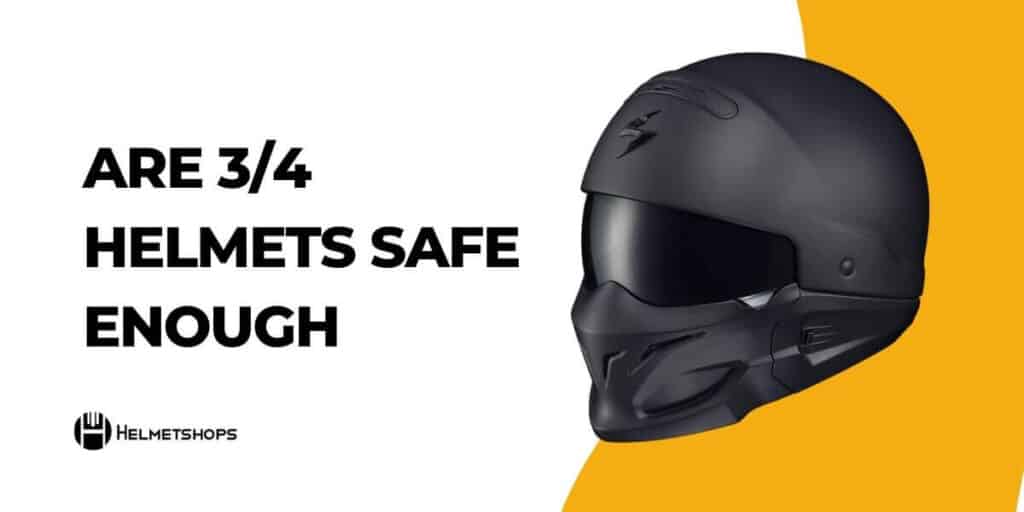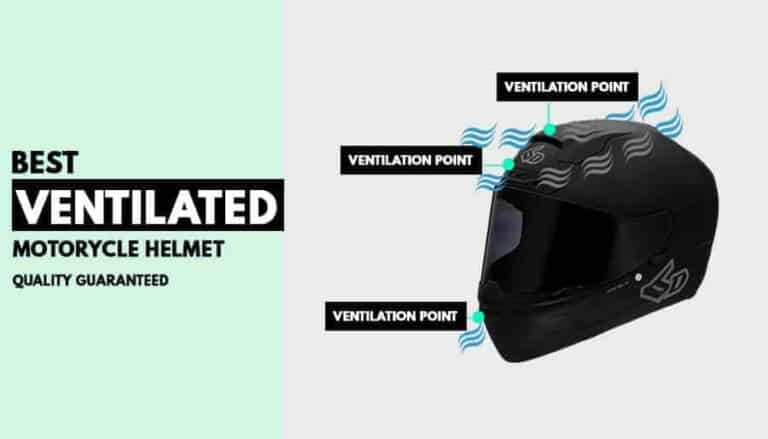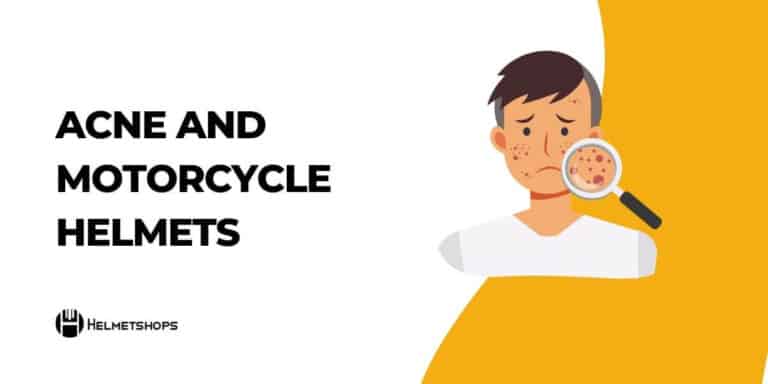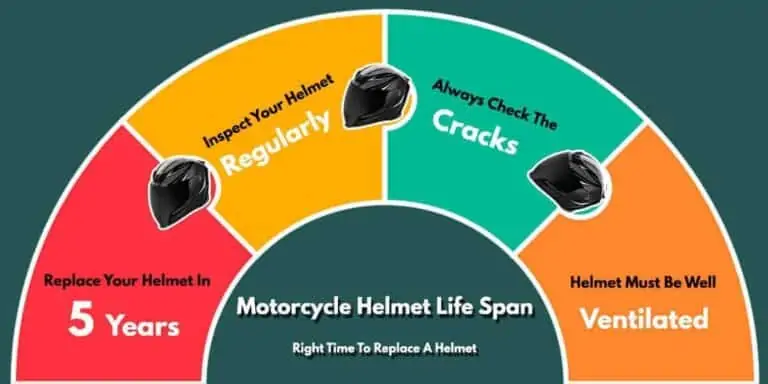Disclosure: As an Amazon Associate We earn from qualifying purchases.
In short, 3/4 helmets are not as safe as full-face helmets due to their limited coverage area. However, they still provide some level of protection for the rider’s head and are legal to use in many places.
If you’re a motorcycle rider, choosing the right type of helmet is crucial to ensure your safety on the road. One of the most common questions riders ask is whether 3/4 helmets are safe. While full-face helmets provide the best protection, 3/4 helmets can be a suitable option in certain situations.
But what exactly are 3/4 helmets, and how do they compare to full-face helmets? In this article, we’ll explore the pros and cons of 3/4 helmets and help you make an informed decision on which type of helmet is right for you.

Understanding The Anatomy Of A 3 4 Helmet
A 3/4 helmet is a popular choice for motorcycle riders looking for a balance between safety and freedom. But what makes it safe? The shell structure of a 3/4 helmet differs from a full-face helmet, providing less coverage for the chin and face.
However, the helmet compensates for this with the additional padding in the interior. The padding is thicker than a half-face helmet and covers more area, providing ample protection to the top of the head. The visor on a 3/4 helmet is also crucial in protecting the rider’s face from impact and debris.
Its design is more extended than a half-face helmet, providing extra coverage for the eyes and forehead. So, are 3/4 helmets safe? The answer is yes, with proper care and usage, it can provide excellent protection while still giving the rider the freedom to enjoy the ride.
Standards And Regulations Of Helmet Safety
When it comes to motorcycle safety, wearing a helmet is non-negotiable. However, not all helmets are equally effective in keeping riders safe. It’s important to understand the different safety standards and certifications before purchasing a helmet. The most commonly recognized standards are dot and ece.
Dot is the standard used in the united states, while ece is the european standard. Both certifications ensure that the helmet is tested for impact protection and penetration resistance, but there are some differences in the testing methods. Ultimately, the best helmet is one that meets both standards and fits properly.
Choose a helmet that prioritizes safety. It can be a life-saving decision.
The Advantages Of Using 3 4 Helmet
A 3 4 helmet is a design that covers the rider’s head, ears and cheeks while leaving the chin exposed. These helmets are a great choice for motorcyclists who want a balance between protection and comfort. The increased visibility that comes with using a 3 4 helmet is a significant advantage.
The open-faced design of this helmet allows for a full range of vision, giving the rider a better view of the road ahead. Additionally, 3 4 helmets have a more comfortable design than full-face helmets. They are lighter and allow more air to circulate around the rider’s head, making for a more comfortable ride.
Be sure to choose a quality helmet that has been certified by a reputable safety organization.
The Disadvantages Of Using 3 4 Helmet
The 3 4 helmets might not be the best choice for riders who value safety. With less coverage than a full-face helmet, riders are at a greater risk of injury in the event of an impact. The lack of chin and neck protection exposes those areas to danger.
Although some riders prefer the 3 4 helmets for their open feel, it’s important to weigh the risks before making a choice. It’s always better to prioritize safety over comfort or style. Invest in a high-quality helmet that provides sufficient coverage and protection for your safety as a responsible rider.
Understanding Proper Sizing And Fit
Proper sizing and fit are crucial when choosing a helmet. Measuring your head size is the first step in finding the right fit. Using a tape measure, wrap it around the widest part of your head above your eyebrows and ears.
Consult the manufacturer’s sizing chart for the helmet you’re interested in to ensure a proper fit. A too-loose helmet could fly off your head during an accident and a too-tight helmet could cause discomfort or even injury. It’s also important to choose the right size based on your head shape.
The goal is to find a snug fit that doesn’t move around on your head. Remember to recheck the sizing every so often, as your head size may change over time.
Tips For Ensuring A Proper Helmet Fit
Wearing a helmet is the most important safety measure you can take while engaging in outdoor activities. Before purchasing a helmet, it is important to make sure that it fits properly. To ensure a proper fit, you should first adjust the chinstrap so that it is snug enough to keep the helmet in place.
Additionally, make sure that the helmet sits low enough on your forehead, covering your forehead and eyebrows. Finally, check for any movement by giving your head a shake to see if the helmet shifts or wobbles. Following these tips can help you ensure that your helmet is providing you with the maximum amount of protection.
Can 3 4 Helmets Provide Adequate Protection Against Accidents?
While 3 4 helmets are popular among riders, it’s crucial to question their safety. 3 4 helmets can provide adequate protection against accidents at low to moderate speeds, but they have some limitations. Compared to full-face helmets, three-fourths offer less protection to the face, chin, and jaw areas.
In real-world crashes, the impact is often concentrated in these areas, making full-face helmets a safer option. 3/4 helmets offer greater comfort and ventilation for riders. Ultimately, the choice between the two will depend on personal preferences and the type of driving you’ll be doing.
It’s essential to keep in mind that safety should always be a top priority when selecting a motorcycle helmet.
Frequently Asked Questions For Are 3 4 Helmets Safe
Are 3 4 Helmets Safe For Motorcycle Riders?
Yes, 3/4 helmets are safe to use, but they come with a few drawbacks such as providing limited protection. These helmets cover the head, temple, and ears, but the face is not covered, so riders may face facial injuries in case of an accident.
What Is The Main Difference Between 3 4 Helmets And Full-Face Helmets?
A 3/4 helmet covers only the top, back, and sides of the head, while a full-face helmet covers the whole head including the face, jaw, and chin. Full-face helmets provide the best protection against abrasion, impact, and even wind noise.
Can A 3/4 Helmet Protect From Wind Noise?
3/4 helmets cannot provide much protection against wind noise since they do not cover the face. They can be equipped with a visor or short windshield, which may help reduce wind blast and noise to some extent.
Who Should Use A 3 4 Helmet?
Riders who prioritize comfort over safety and ride at lower speeds or short distances within a city can opt for 3/4 helmets. These helmets are also ideal for cruisers, scooters, or vintage motorcycles.
Is It Legal To Use A 3 4 Helmet For Riding In The US?
3/4 helmets are legal for use on most roads in the US, provided they meet safety standards set by the department of transportation (dot). Some states may have their own standards; hence it’s recommended to check the local laws before buying one.
Conclusion
After exploring the pros and cons of wearing a 3 4 helmet, it’s safe to say that this type of helmet is just as safe as a full-face helmet. It provides ample protection to the rider’s head and a certain level of airflow to keep them cool.
With the advancement of technology, 3 4 helmets have become more comfortable, lightweight, and aerodynamic. However, it’s important to note that this type of helmet is not suitable for all types of riders. Individuals who engage in high-speed racing or off-road adventures may need a more heavy-duty helmet.
At the end of the day, it’s your personal preference and comfort that matters. If you’re looking for a lightweight and stylish helmet that provides sufficient protection, then a 3 4 helmet is a great option for you. But if safety is your top priority, investing in a full-face helmet may be your best bet.
Ultimately, make sure to pick a helmet that fits you well, meets all safety standards, and provides reliable protection while you’re on the road. Ride safe, ride smart!






